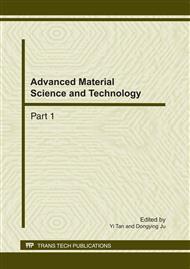p.295
p.299
p.303
p.307
p.311
p.317
p.321
p.325
p.329
Urea Effect on Strong Electrorheological Response of Novel Core-Shell Nanoparticles
Abstract:
Electrorheological (ER) fluids are regarded as smart materials with potential for application in various industries because of the controllable viscosity, the reversibly and fast response. In this paper, core-shell structured Ni/Ti/Urea nanoparticles, as an ER material, were prepared by a sol-gel method. TEM, XRD and FT-IR spectra demonstrated that the Ni nanoparticles have been homogeneously coated with a 2 nm thick layer of TiO2 containing polar groups. The polar groups were caused by the introduction of urea. The ER effect of the fluids of Ni/Ti/Urea particles in silicone oil was investigated under a DC electric field. It is found that the ER fluids of the urea-doped Ni/TiO2/Urea particles have a high ER activity, which is 10 times that of the particles containing no urea. The polar groups in the particles are the intrinsic reasons for the enhancement of electrorheological effect.
Info:
Periodical:
Pages:
311-314
Citation:
Online since:
February 2011
Authors:
Keywords:
Price:
Сopyright:
© 2011 Trans Tech Publications Ltd. All Rights Reserved
Share:
Citation:


